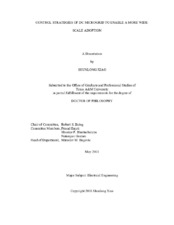| dc.description.abstract | Microgrids are gaining popularity in part for their ability to support increased penetration
of distributed renewable energy sources, aiming to meet energy demand and overcome global
warming concerns. DC microgrid, though appears promising, introduces many challenges in the
design of control systems in order to ensure a reliable, secure and economical operation. To enable
a wider adoption of DC microgrid, this dissertation examines to combine the characteristics and
advantages of model predictive control (MPC) and distributed droop control into a hierarchy and
fully autonomous control of the DC microgrid. In addition, new maximum power point tracking
technique (MPPT) for solar power and active power decoupling technique for the inverter are
presented to improve the efficiency and reliability of the DC microgrid.
With the purpose of eliminating the oscillation around the maximum power point (MPP),
an improved MPPT technique was proposed by adding a steady state MPP determination algorithm
after the adaptive perturb and observe method. This control method is proved independent with
the environmental conditions and has much smaller oscillations around the MPP compared to
existing ones. Therefore, it helps increase the energy harvest efficiency of the DC microgrid with
less continuous DC power ripple.
A novel hierarchy strategy consisting of two control loops is proposed to the DC microgrid
in study, which is composed of two PV boost converters, two battery bi-directional converters and
one multi-level packed-u-cell inverter with grid connected. The primary loop task is the control of
each energy unit in the DC microgrid based on model predictive current control. Compared with
traditional PI controllers, MPC speeds up the control loop since it predicts error before the
switching signal is applied to the converter. It is also free of tuning through the minimization of a
flexible user-defined cost function. Thus, the proposed primary loop enables the system to be
expandable by adding additional energy generation units without affecting the existing ones.
Moreover, the maximum power point tracking and battery energy management of each energy unit
are included in this loop. The proposed MPC also achieves unity power factor, low grid current
total harmonics distortion. The secondary loop based on the proposed autonomous droop control
identifies the operation modes for each converter: current source converter (CSC) or voltage source
converter (VSC). To reduce the dependence on the high bandwidth communication line, the DC
bus voltage is utilized as the trigger signal to the change of operation modes. With the sacrifice of
small variations of bus voltage, a fully autonomous control can be realized. The proposed
distributed droop control of different unit converters also eliminates the potential conflicts when
more than two converters compete for the VSC mode.
Single-phase inverter systems in the DC microgrid have low frequency power ripple, which
adversely affects the system reliability and performance. A power decoupling circuit based on the
proposed dual buck converters are proposed to address the challenges. The topology is free of
shoot-through and deadtime concern and the control is independent with that of the main power
stage circuit, which makes the design simpler and more reliable. Moreover, the design of both PI
and MPC controllers are discussed and compared. While, both methods present satisfied
decoupling performances on the system, the proposed MPC is simpler to be implemented.
In conclusion, the DC microgrid may be more widely adopted in the future with the
proposed control strategies to address the current challenges that hinder its further development. | en |


